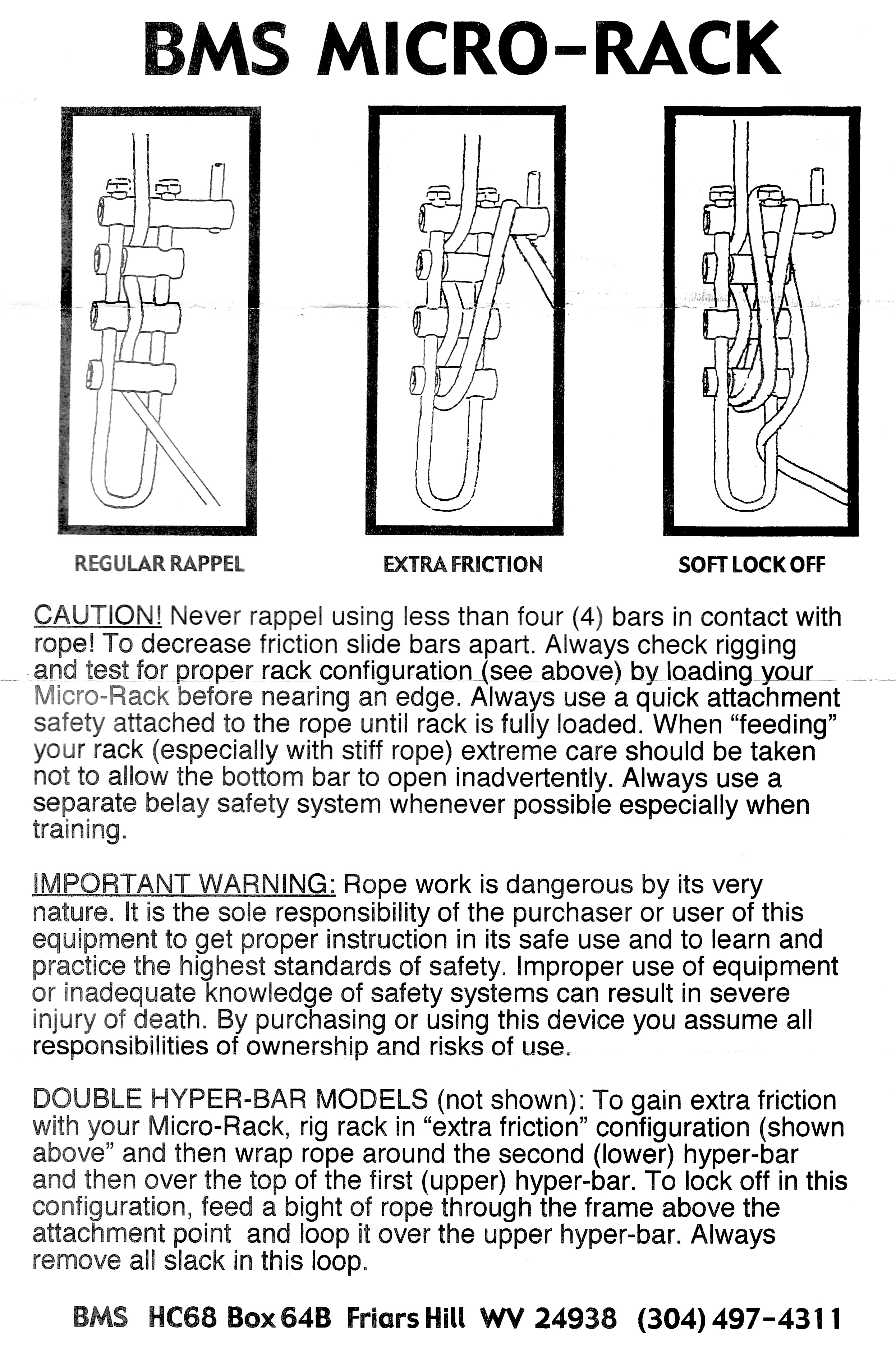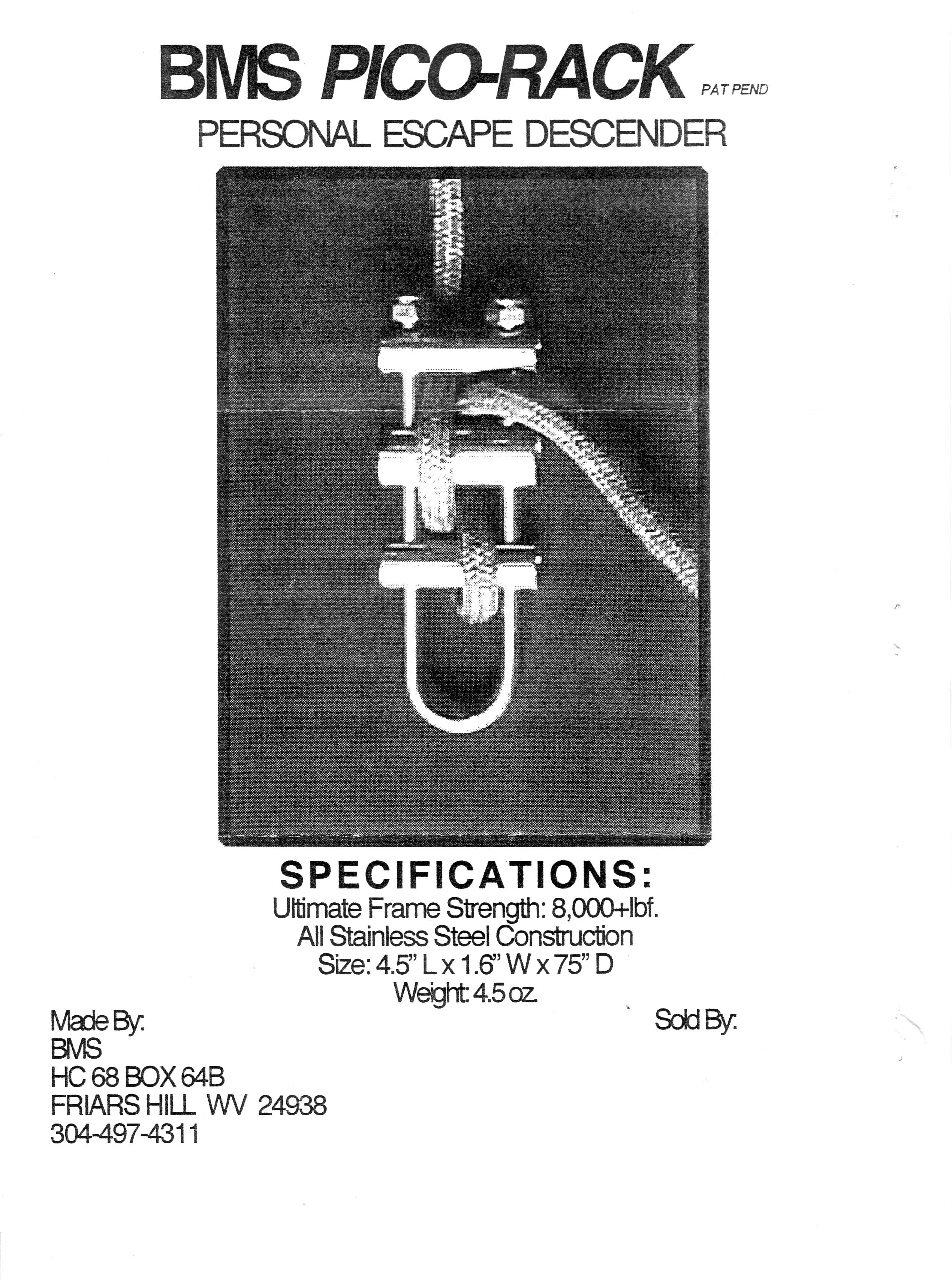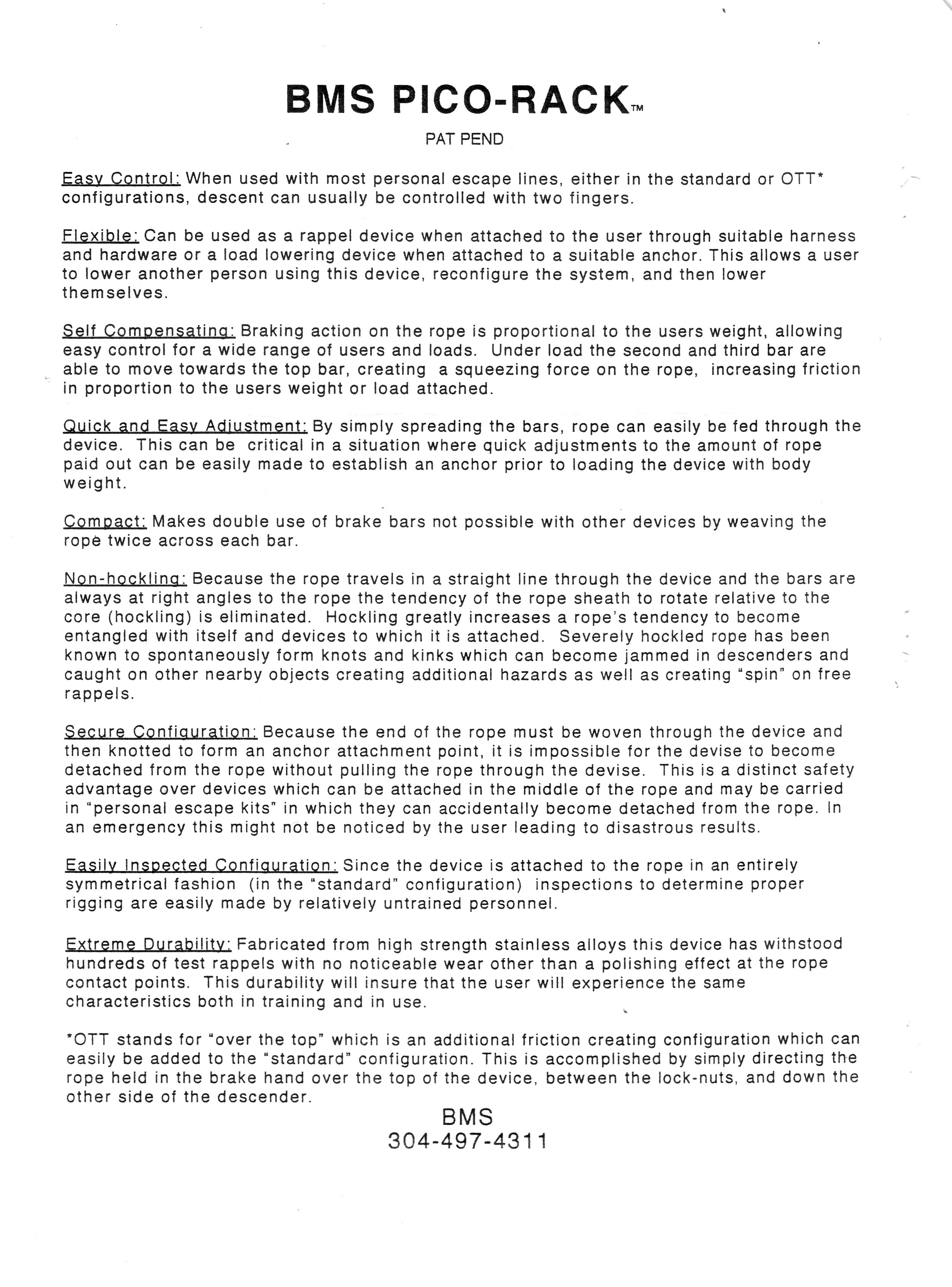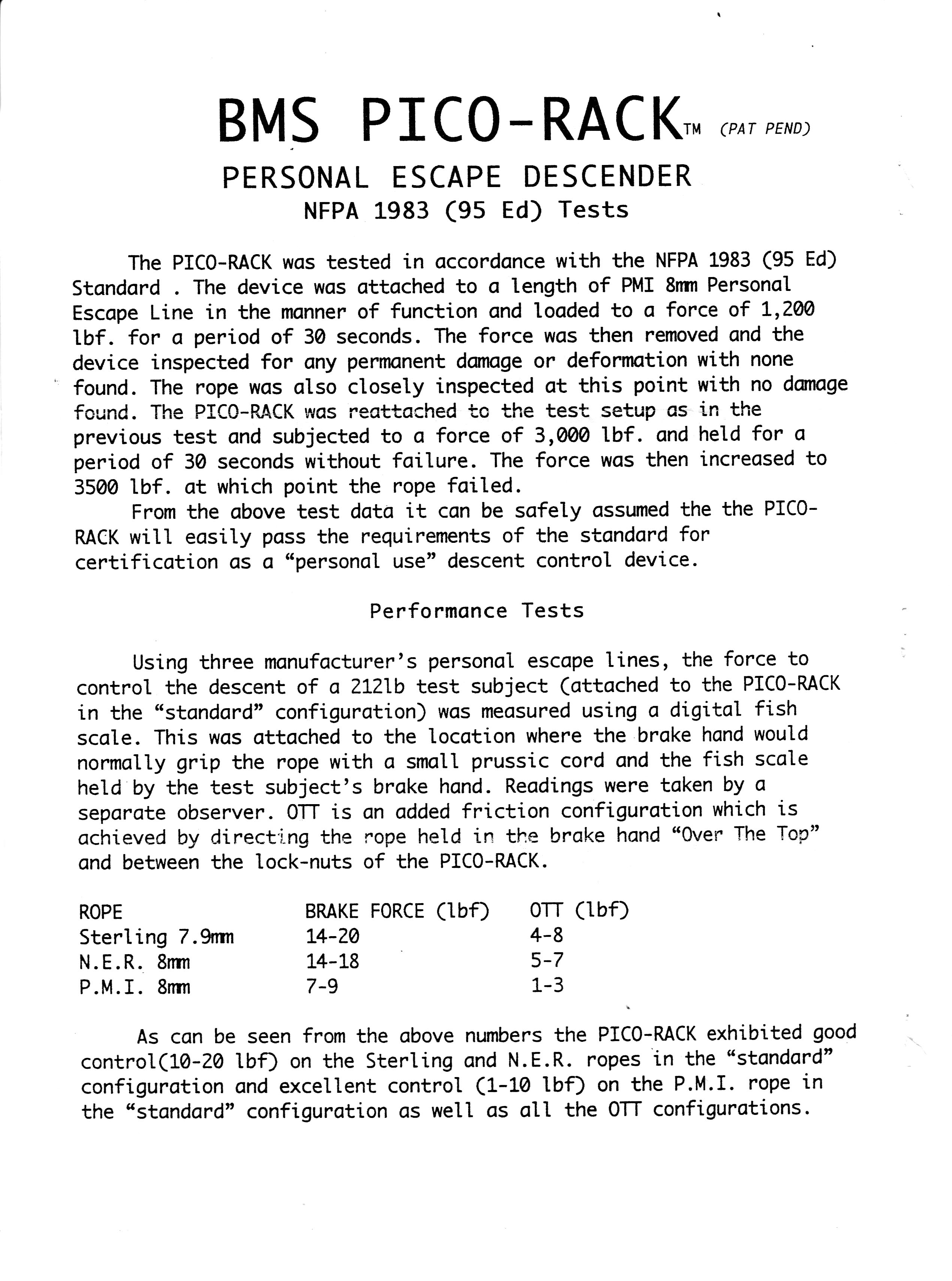Overview
[ Top
| Standard, v. B
| Micro, v. A
| Micro, v. B
| Micro, v. C
| Mini
| Pico
| Experimental
| Return to Racks
]
Standard, Version A
(#527)
Technical Details
I acquired this rack from Inner Mountain Outfitters at the
1997 NSS Convention.
My Bassett Metal Studios, Version A rack is 310 mm. tall,
120 mm. wide, 24 mm. thick, and weighs 824 g.
The frame is made from 9.5 mm. stainless steel bent into
a U, with an internal width of 33 mm. There are six brake
bars, all made from 21 mm. diameter stainless steel tubing.
The top bar is a 119 mm. long dual hyperbar, while
the remaining five are 64 mm. long standard bars. Allowing
35 mm. for the rope leaves 94 mm. range for spreading
the bars.
There are no markings on this rack.
The top hyperbar provides a convenient tie-off at the expense
of making the rack unnecessarily bulky. Although I like hyperbars
on smaller racks where I can use them to increase friction and
compensate for having fewer bars, on larger ones I find them superfluous
since I am not particularly interested in having another tie-off
method.
[ Top
| Standard, v. A
| Micro, v. A
| Micro, v. B
| Micro, v. C
| Mini
| Pico
| Experimental
| Return to Racks
]
Standard, Version B
(#1006)
Technical Details
I acquired this rack from Barry Duncan at the 2005 Old Timers
Reunion.
My Bassett Metal Studios, Version B rack is 255 mm. tall,
120 mm. wide, 22 mm. thick, and weighs 702 g.
The frame is made from 9.5 mm. stainless steel bent into
a U, with an internal width of 34 mm. There are four brake
bars, all made from 21 mm. diameter stainless steel tubing.
The top bar is a 120 mm. long dual hyperbar, and the
third bar is the same, inverted. Neither is slotted. The second
and fourth bars are 64 mm. long standard slotted bars. Allowing
35 mm. for the rope leaves 97 mm. range for spreading
the bars.
There are no markings on this rack.
For a standard-sized rack, hyperbars may be unnecessary but
I'll allow for differences of opinion, but by the time one doubles
the hyperbar and then adds a second, inverted hyperbar and doubles
that, I think one is going a bit to far for normal use. The result
is big, bulky, and has enough prongs to catch on just about anything.
[ Top
| Standard, v. A
| Standard, v. B
| Micro, v. B
| Micro, v. C
| Mini
| Pico
| Experimental
| Return to Racks
]
Microrack, Version A
(#1234)
Technical Details
 I acquired this rack from Howie’s Harnesses at the 2009 UIS/NSS Convention.
I acquired this rack from Howie’s Harnesses at the 2009 UIS/NSS Convention.
This Microrack rack is 269 mm. tall, 70 mm. wide, 27 mm. thick, and weighs 430 g. The frame is made from 7.9 mm. stainless steel bent into a U, with an internal width of 18 mm. There are four brake bars, including one hyperbar and three standard hollow SS bars. The bars are 21 mm. in diameter and 70 and 45 mm. long, respectively. Allowing 35 mm. for the rope leaves 109 mm. for spreading the bars.
There are no markings on this rack.
The nomenclatural absurdity of having this Microrack be larger than the Mini arose through historical accident.
The top bar is a hyperbar, that allows looping the rope over
the bar to increase friction. While I don't see a need for hyperbars
on a standard size rack, I like having them on small 4-bar racks
because such racks often don't provide enough friction. Some people use an upside-down hyper bar as the third bar, but that is carrying the hyperbar idea too far for my taste.
Allowing the fourth bar to open while maneuvering on rope can be dangerous. John Woods invented a brake bar latch to help reduce the chance of this happening.
[ Top
| Standard, v. A
| Standard, v. B
| Micro, v. A
| Micro, v. C
| Mini
| Pico
| Experimental
| Return to Racks
]
Microrack, Version B
(#2458, 3215)
Technical Details
I acquired one rack from On Rope 1 at the 2017 NSS Convention and another from Kelley Deem at the 2022 Old Timers Reunion.
Version B is 228 mm.
tall, 70 mm.
wide, 25 mm.
thick, and weighs 401 g.
The frame is made from 7.9 mm.
stainless steel bent into a U, with an internal width of 18 mm.
There are four brake bars, including one hyperbar and three standard hollow SS bars. The bars are 21 mm.
in diameter and 70 and 45 mm.
long, respectively. Allowing 35 mm.
for the rope leaves 65 mm.
for spreading the bars.
There are no markings on this rack.
The current standard microrack seems to be more or less the same as the Mini was, except that the current Microrack has larger diameter bars.
The top bar is a hyperbar, that allows looping the rope over
the bar to increase friction. While I don't see a need for hyperbars
on a standard size rack, I like having them on small 4-bar racks
because such racks often don't provide enough friction.
Allowing the fourth bar to open while maneuvering on rope can be dangerous. John Woods invented a brake bar latch to help reduce the chance of this happening.
[ Top
| Standard, v. A
| Standard, v. B
| Micro, v. A
| Micro, v. B
| Mini
| Pico
| Experimental
| Return to Racks
]
Microrack, Version C
(#3186)
Technical Details
I acquired this rack from Shawn Edgecomb (refined_trades) in 2022.
Version C is 229 mm.
tall, 70 mm.
wide, 21 mm.
thick, and weighs 440 g.
The frame is made from 7.9 mm.
stainless steel bent into a U, with an internal width of 18 mm.
There are four brake bars, including one hyperbar, one inverted hyperbar in the third position, and two standard hollow SS bars. The bars are 21 mm.
in diameter and 70 and 45 mm.
long, respectively. Allowing 35 mm.
for the rope leaves 65 mm.
for spreading the bars.
There are no markings on this rack.
The top bar is a hyperbar, that allows looping the rope over
the bar to increase friction. While I don't see a need for hyperbars
on a standard size rack, I like having them on small 4-bar racks
because such racks often don't provide enough friction. Some people use an upside-down hyper bar as the third bar, but that is carrying the hyperbar idea too far for my taste.
Allowing the fourth bar to open while maneuvering on rope can be dangerous. John Woods invented a brake bar latch to help reduce the chance of this happening.
[ Top
| Standard, v. A
| Standard, v. B
| Micro, v. A
| Micro, v. B
| Micro, v. C
| Pico
| Experimental
| Return to Racks
]
Mini
(#389)
Technical Details
I acquired this rack from John E. Weinel, Inc. at the 1994
Old Timers Reunion.
My Bassett Metal Studios Mini is 225 mm. tall, 63 mm. wide, 19 mm. thick, and weighs 348 g. The frame is
made from 7.9 mm. stainless steel bent into a U, with an
internal width of 16 mm. There are 4 brake bars. The bars
are made from 19 mm. diameter stainless steel tubing. The
top bar is a 67 mm. long single-sided hyperbar. The
remaining bars are 45 mm. long. Allowing 35 mm. for
the rope gives a 72 mm. for spreading the bars.
There are no markings on this rack.
The top bar is a hyperbar, that allows looping the rope over
the bar to increase friction. While I don't see a need for hyperbars
on a standard size rack, I like having them on small 4-bar racks
because such racks often don't provide enough friction.
Allowing the fourth bar to open while maneuvering on rope can be dangerous. John Woods invented a brake bar latch to help reduce the chance of this happening.
[ Top
| Standard, v. A
| Standard, v. B
| Micro, v. A
| Micro, v. B
| Micro, v. C
| Mini
| Experimental
| Return to Racks
]
Pico-Rack
(#549, 2400, 2474)
Technical Details
 I acquired this rack from Bassett Metal Studios at the 1997
NSS Convention. I acquired another in 2017 as part of Bob Thrun’s collection, and a third from Bill Liebman at the 2017 Old Timers Reunion.
I acquired this rack from Bassett Metal Studios at the 1997
NSS Convention. I acquired another in 2017 as part of Bob Thrun’s collection, and a third from Bill Liebman at the 2017 Old Timers Reunion.
My Bassett
Metal Studios Pico-rack rack is 119 mm. tall, 41 mm. wide, 18 mm. thick, and weighs 150 g. The frame is
made from 6.4 mm. stainless steel bent into a U, with an
internal width of 19 mm. There are three brake bars made
from stainless steel tubing. The top two bars are 17 mm. in diameter and the third bar is 14 mm. All three bars are
41 mm. long; none are slotted.
The Pico-Rack is a Personal Escape Device, and is tested to NFPA requirements for such devices. This is the kind of device that I carry when riding ski lifts, since being prepared effectively prevents lift failure. The bars do not pivot, and the device must be pre-rigged on the rope. It is designed for 8 mm. rope - not standard caving or climbing ropes. Note the way the rope runs: with only three bars, this is important. It also provides an increase in friction for heavier people, since the rappeller’s weight forces the bars together.
The Pico-Rack received U.S. Patent #6,131,697.
[ Top
| Standard, v. A
| Standard, v. B
| Micro, v. A
| Micro, v. B
| Micro, v. C
| Mini
| Pico
| Return to Racks
]
Experimental
(#3308)
Technical Details
Carroll Bassett gave me this rack in 2023.
This rack is 163 mm. tall, 69 mm. wide, 20 mm. thick, and weighs 217 g. The frame is made from 7.9 mm. stainless steel bent into a U, with an internal width of 19 mm. There are two brake bars made from 20 mm. squaretubing with a 1.5 mm. wall thickness. The
top bar is a 69 mm. long single-sided hyperbar. The
other bar is 45 mm. long. Allowing 35 mm. for
the rope leaves 56 mm. for spreading the bars.
There are no markings on this rack.
Carroll never intended to have this rack taken seriously. He called it "ridiculous" and made it only as a joke - but he did try it once. Two thin-walled square bars are just asking for trouble.
[ Top
| Standard, v. A
| Standard, v. B
| Micro, v. A
| Micro, v. B
| Micro, v. C
| Mini
| Pico
| Experimental
]






